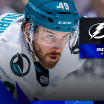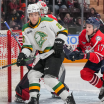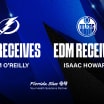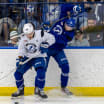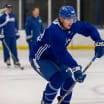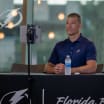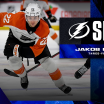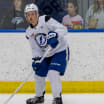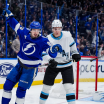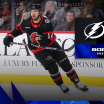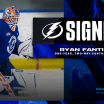While the Tampa Bay Lightning are competing in the 2020 Stanley Cup Playoffs inside a bubble in Toronto, the Lightning's broadcast teams are cocooned in their own bubble over 1,000 miles away at AMALIE Arena.
The broadcasters don't have the luxury of calling the games from their normal perches high up in the press box at Toronto's Scotiabank Arena, where the Lightning have played all of their games so far this postseason and will continue to do so through the first two rounds of the playoffs.
Instead, the broadcast teams are in separate places inside AMALIE Arena, calling the action off of the same television feed you or I are watching the games from.
The broadcast has suffered little if at all in these unique circumstances forced upon the crews by the coronavirus. Goals might be a little trickier to call because there's no fan reaction to give a hint as to what happened and the red light behind the net isn't always visible on the screen. But the announcers continue to bring Lightning fans the high level of detail and insightfulness they've come to expect from a Bolts broadcast.
During Tampa Bay's second round robin game against the Boston Bruins Wednesday, I was allowed inside AMALIE Arena to watch how the broadcast teams continue to deliver a professional broadcast despite the obstacles that are making their jobs much more difficult.
Here's what I observed.
Socially distant broadcasting from 1,000 miles away
Stationed at Amalie Arena, Bolts radio and TV broadcasters overcome logistical challenges to bring fans inside the bubble
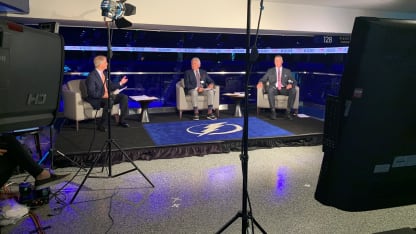
Lightning Radio play-by-play announcer Dave Mishkin and color commentator Phil Esposito are set up at a desk on top of a riser inside the event level media room at AMALIE Arena.
They're sitting in roughly the same spot where Lightning head coach Jon Cooper stands at a podium for his post-game press conferences.
Mishkin and Esposito are calling the game from two 75-inch televisions anchored to the wall in front of them. Off to the right is another large-screen TV on a stand that shows the uninterrupted feed from Scotiabank Arena so they can see what's happening during breaks. This live feed is particularly useful when a penalty has been called right as the broadcast goes to a commercial, Mishkin and Esposito can see who is in the penalty box and which team will have a power play once the game returns.
When walking into the media room, Mishkin is on the left and Esposito is on the right. Separating the two is a piece of the rink glass usually found atop the boards at AMALIE Arena. It's been cut down and placed as a divider between the announcers' positions, rising up out of the table about three feet high to stop any particles that might fly out of the maskless announcers as they call the game.
To their left is Steve Versnick, the radio producer for Lightning Radio. In addition to manning the sound boards that ensure the broadcast is being delivered over the airwaves to Bolts Nation, Versnick is on the phone with a statistician in Toronto throughout the game getting live updates. If somebody scores or a penalty is called, Versnick knows about 15 seconds before anybody else in Tampa because the stat guy is giving him the scoring or penalty summary. When Tyler Johnson scores his game-winning goal with 1:27 remaining in the Boston game, Versnick gets my attention and mouths "goal" while pointing at the screen. It's interesting watching and knowing a goal is about to happen, seeing how what looks to be a nothing play transpires into a goal, a win and two more points.
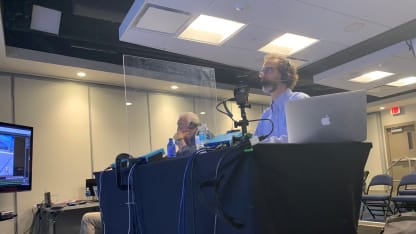
An hour before game time, FOX Sports play-by-play announcer Rick Peckham and color commentator Brian Engblom are running through the pre-game show with their producers who are socially distanced inside a trailer parked just outside AMALIE Arena in the players' compound. Through their headsets, a voice from the truck is giving instructions
"You sounded like Peyton Manning there," Engblom jokes to the producer.
"Omaha, Omaha," Peckham laughs.
FOX Sports Sun is putting safety first with their production team and broadcasters, so much so that no one is allowed to enter the TV truck or broadcast booth that isn't essential to the production you see on TV. I was able to observe from a distance, outside Peckham's and Engblom's booth, from the press box common area where the press typically chats and snacks during intermissions when covering games from AMALIE Arena was a thing.
Peckham is sitting in his typical spot in the home TV broadcast booth. Engblom is in the booth to his right, where the visiting TV crew usually sits. They have to stay in separate booths throughout the broadcast because of coronavirus restrictions, even during their live hit toward the end of the pregame show when they're typically shoulder-to-shoulder. Now, they do it from their separate booths. Each has a camera set up facing toward the ice in the back of the booth to accomplish this live hit.
During a game currently, the way Peckham and Engblom call the action is not much different than how they would work under normal circumstances. Engblom likes to be between the benches because it gives him a better feel for the game and he's able to get a lot of the back-and-forth banter that goes on between opponents, so Peckham's used to doing games from his booth by himself. And Engblom is comfortable not having his broadcast partner right next to him.
"It's not difficult for us," Engblom says.
The rundown of the pregame show is basically a condensed version of all the stories they'll highlight and graphics they'll use in the 30-minute show that leads into the actual game broadcast. Today, there's a montage on the 45 hits the Lightning dished out against Washington in the first round robin contest, the third-highest hit total in Tampa Bay playoff history. There's a graphic on Kucherov scoring his 30th career playoff goal and joining Martin St. Louis as the only two Bolts to reach that number.
Peckham has four monitors on the counter in front of him. To his right is a medium-sized TV from which he'll call the game. Engblom has the same monitor in his booth too. For the game against Washington, the feed was played on the giant Lightning Vision board inside AMALIE Arena, but they won't use the big screen today.
Or going forward it seems.
"For depth purposes, it's a little easier to see it up close on the smaller monitor," Engblom explains.
There's another monitor in each of the booths that shows the Toronto feed so they can watch what's going on during warmups and breaks. Typically, the broadcasters would be able to see the line combinations, defensive pairings and who's in and out of the lineup while watching warmups.
They don't have that luxury during these broadcasts but can glean a little bit of what's to come from the arena feed.
A third monitor in Peckham's booth displays scripted reads that play throughout the game. Like when the broadcast comes back from commercial during an intermission and there's a shot of the Toronto cityscape and Peckham's voice intoning, "Tampa Bay Lightning on FOX Sports Sun, brought to you by …"
All of those voiceovers are recorded before the game and added into the broadcast later. Peckham runs through about five of them during this pre-game session. He's the consummate pro on these reads, adding energy and inflection even from an empty booth in a quiet arena. One of the reads still says FOX Sports Sun even though today's game will be carried on FOX Sports Florida. Peckham doesn't even hesitate when he gets to it, correctly saying FOX Sports Florida instead of what's written on the screen.
Directly in front of Peckham is a fourth and final screen, which is actually just an iPad with game notes at his fingertips (as the person who puts together the game notes for the Lightning, I get a kick and an ego boost hearing the broadcasters interject these notes throughout their call).
After they finish their pre-game run down, Peckham jokes how he should toss the show back to Paul Kennedy hosting across the rink on the concourse by just yelling out of his booth, "Hey Paul, back to you!"
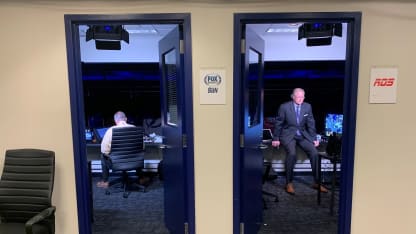
In Section 128, Kennedy, Bobby "The Chief" Taylor and Dave Andreychuk are sitting in chairs six feet apart without their typical broadcast desk in front of them. Instead, there's a large Lightning-logo carpet at their feet, and you can see them from the waist down, which is different. Kennedy likes to take pictures of Chief's sock and shoe combination and post them to his Twitter account.
Usually as the gang is doing their pre-game show, there are fans filling AMALIE Arena and the players are warming up on the ice.
Now, the arena is silent and motionless.
A couple cameramen film the pre-game show from different angles. Kennedy, Taylor and Andreychuk have a monitor in front of them playing highlights from the Washington game, which they're breaking down.
Kennedy has a small table over to his left where he has his notes and reads he'll say during the broadcast. Usually he'll have those at his fingertips sitting on the desk right in front of him.
"I needed a place to put my notes, so we came up with the table," Kennedy tells me. "Sometimes I find myself fumbling through my papers, but we make it work."
Otherwise, the pre-game setup isn't too different from what the trio are used to working with. The commotion from the fans around them, the action on the ice, the bright arena lights and the warmup music is missing, but their job and their ability to do it remains unchanged.
The only difference now is they're doing it in the echo chamber of an empty arena. Their voices boom down the concourse, so much so you can hear them from five or six sections away.
The only other noise around them comes from a packing tape dispenser.
RRRRRIIIIIIIIIIIPPPPPPPP
Workers at the nearby Tampa Bay Sports store in Section 126 are filling boxes with merchandise.
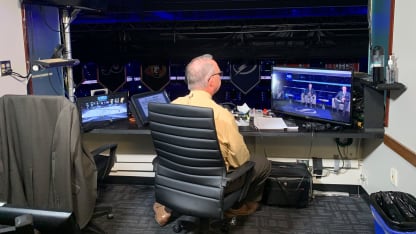
Back inside the media room for the radio pregame broadcast, the show starts 30 minutes before the scheduled puck drop but most of the segments have been pre-taped so Mishkin and Esposito spend the majority of their time watching Nashville-Arizona on the big screen to their right, which will stay on until the Lightning-Bruins game begins.
Mishkin has his headphones around his neck, listening to the pregame as it rolls along.
Mishkin and Esposito are discussing whether a hit by Austin Watson on Oliver Ekman-Larsson was clean (it was) and the quality of the ice.
Two separate times, Esposito asks who a certain player is on the ice.
"Who's number 83?" he quizzes Mishkin on the second one.
"That's Conor Garland," Mishkin answers immediately. "He was with their AHL team in Tucson for a couple of years before getting called up last season."
Mishkin's knowledge of every player in the league, even teams the Lightning only see twice during a season, is unparalleled.
Esposito is as much a treasure to listen to before games as he is on the air. He has opinions and voices them all in his unique way.
On Toronto: "It's a good place to be, but not for me."
On the ice: "See how that puck is bouncing around guys? Both teams gotta be careful in these games."
He says the name of Lightning defenseman Zach Bogosian into his headset, pronouncing each syllable of Bogosian with elan. Most people say "Bogosian" as three syllables, the last four letters coming together as one. But Esposito's version is four distinct syllables, each one more drawn out than the last.
The game starts, and the duo falls into their familiar roles. Mishkin does most of the talking, describing every movement of the puck with impeccable accuracy. If something big is about to happen, Mishkin rises ever so slightly out of his seat, ready to erupt for a Lightning goal.
Esposito is watching intently. Whenever there's a break in the play or in Mishkin's rat-a-tat, he adds his thoughts, breaking down why a scoring play happened or adding tidbits from when he was a player how a particular action might have unfolded.
Versnick motions for me to come over and listen to the broadcast on one of the empty headsets. I can hear the pumped-in crowd noise as well as all the other sounds of the game: the whistles, the in-game arena music, a puck hitting a stick, skate blades, ice being carved, a body hitting the glass.
Mishkin and Esposito can hear these sounds in their headsets as well, making it feel like they're as close to the game as possible from 1,000 miles away.
"It's not the same as when you're in the arena with the fans and the noise," Esposito says during a break.
"We've got a great monitor to watch it on though," Mishkin replies.
"You're right about that," Esposito says.
There's an ongoing dialogue between the two during breaks, almost as if they're continuing to add their insight into the game, but the fans don't get the benefit of hearing it.
"That's when they got in trouble, plays just like that," Esposito says about a turnover right before the break that led to a good scoring chance for the Bruins.
"The Lightning have been really good in the first period on face-offs," Mishkin says.
"They were good against Washington too," Esposito replies.
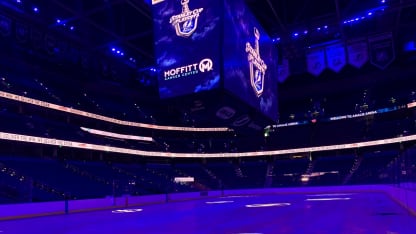
In the press box for the second period, it's interesting to watch Peckham and Engblom hold a conversation basically through the wall of their respective booths. As they're about to come back on the air, Engblom mentions a funny joke Peckham told during a break in the first period.
"Rick, you almost did me in with that last live," Engblom says. "We were coming back on the air, and I was about to lose it."
Engblom chuckles for a good 10 seconds to himself recalling the joke. He's about to lose it again just thinking about it.
Some of the best commentary between Peckham and Engblom comes during these off-air segments when they can be a little looser.
During the first media break of the second period, they're talking about whether the Bruins have something against Blake Coleman, who got into a fight with Torey Krug in the first period and seems to draw the ire of the Bruins with every shift. They wonder if it stems from his time with the New Jersey Devils. A cross-check delivered by Brad Marchand against Coleman precipitates this conversation.
When they come out of the break, Engblom uses this on the air, and the broadcast is off and running again.
Before the game, Engblom told me a story from the first round robin game against Washington when they were coming out of a break and he got confused where the action was coming from for a moment.
"I was looking down checking stats and as we were about to come back on the air, I started to look down at the arena ice like the game was going to happen right in front of me like we're used to seeing," he said. "It took me half a second to figure out why I wasn't seeing anybody down there.
"It takes some getting used to, but we're adjusting."
I look over at Peckham as they're about to go on the air. I'm heading down the press box stairs to watch the radio broadcasters before coming back up for the second period.
"Well, we'll see you, Burnsie," he says. "Time for us to settle in and watch some TV."

